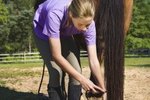You will likely detect a severe leg break easily; your horse will not want to put any weight on that limb. You will typically see severe swelling and in the case of a compound fracture, will see a piece of bone piercing the skin. Also take note if your horse:
- intermittently lifts his leg up;
- stands with his foot or leg at a strange angle or takes any type of unusual stance;
- and if he resists you touching any area of his leg.
Contact your veterinarian immediately for any sign of lameness. While even a severe break is not the automatic death knell for a horse that it used to be, a mild fracture can become severe without immediate and proper treatment.
A mild fracture can become severe without immediate and proper treatment.
Incomplete Fracture
An incomplete fracture is a mixed blessing: On one hand, it's less serious than a complete or compound fracture; on the other hand, the symptoms may be so minor that an accurate diagnosis is delayed or missed, which can lead to a severe fracture.
Also called a "green stick" fracture, an incomplete fracture doesn't result in the bone being split into pieces. To add to the difficult diagnosis, most green stick fractures don't result from any traumatic or sudden injuries, such as a kick by another horse, so you won't see visible signs of trauma. Many of these breaks occur in older or seasoned horses as a result of repeated stress on the bones.
Your veterinarian may have a hard time detecting the fracture on x-rays, so he may need to perform a nuclear scintigraphy or bone scan. Your horse has a very good chance of recovering from an incomplete fracture, so report any lameness, even intermittent, to your veterinarian immediately to increase his chances of a full recovery.
Tips
Keep even a mildly lame horse stalled or confined until your veterinarian can examine him.
Complete and Compound Fractures
You will find it easier to detect a complete fracture, where the bone breaks into two or more pieces. Typically you'll notice swelling and signs of an injury, such as from a fall or kick. Your horse will likely be severely lame and may try to move around on three legs -- in some cases, with the broken leg hanging crookedly. The fewer breaks there are, the easier it is for your vet to successfully treat a complete fracture by piecing the bones back together: A simple complete fracture is two pieces of broken bone; more than two breaks is a comminuted fracture.
In severe cases, a piece of bone will be protruding through the skin. This indicates your horse suffered a compound fracture. Your horse may recover, but treatment will be more lengthy and expensive than with other types of fractures, and his physical performance is likely to be limited.
Tips
Some fractures can cause a piece of bone to break or chip away; these "bone chips" can often be surgically removed with successful outcomes.
Fracture Location
While prompt treatment is important regardless of fracture type, where the fracture occurs is also central to your horse's prognosis. If your horse fractures a tibia he may heal completely enough to resume his normal level of performance. On the other hand, a fractured joint may lead to long-term issues and even discomfort, even if the fracture is surgically repaired.
This also depends on the joint fracture's severity. Some joints can be successfully fused so that your horse can compete or be ridden. Some hock fractures may only require stall rest, as long as they don't involve the calcaneus, or very tip of the hock.
The fracture is not the only consideration, however; in traumatic injuries such as a kick or trailering accidents, damage to ligaments and blood vessels are also common. These injuries may not heal sufficiently for a positive outcome, even if the fracture does.
Warnings
Certain fractures may lead to lameness far removed from the fracture location; for example, a scapular fracture occurs up at the spine and shoulder blade, but you notice lameness in your horse's front legs.
Before and After Treatment
What you do when you first notice signs of a possible fracture is critical to your horse's ultimate return to soundness. Get him to a confined area as soon as possible -- ideally to an area close by so his walking is kept to a minimum. If your veterinarian is delayed, apply a bandage to serve as a splint. If you are unsure how to apply one, contact your veterinarian's office for guidance. The splint will help keep your horse's leg immobilized.
Once your horse has been treated, your job is to keep your horse healthy to aid in his recovery. One unfortunate consequence of a broken leg is laminitis on the healthy leg due to the extra pressure this leg takes while the broken leg is healing. Keep your horse's stall soft with deep shavings to minimize the stress on his healthy leg and foot. Many veterinarians recommend wrapping the healthy leg to help reduce the pressure.
References
Writer Bio
Based in Central Texas, Karen S. Johnson is a marketing professional with more than 30 years' experience and specializes in business and equestrian topics. Her articles have appeared in several trade and business publications such as the Houston Chronicle. Johnson also co-authored a series of communications publications for the U.S. Agency for International Development. She holds a Bachelor of Science in speech from UT-Austin.





